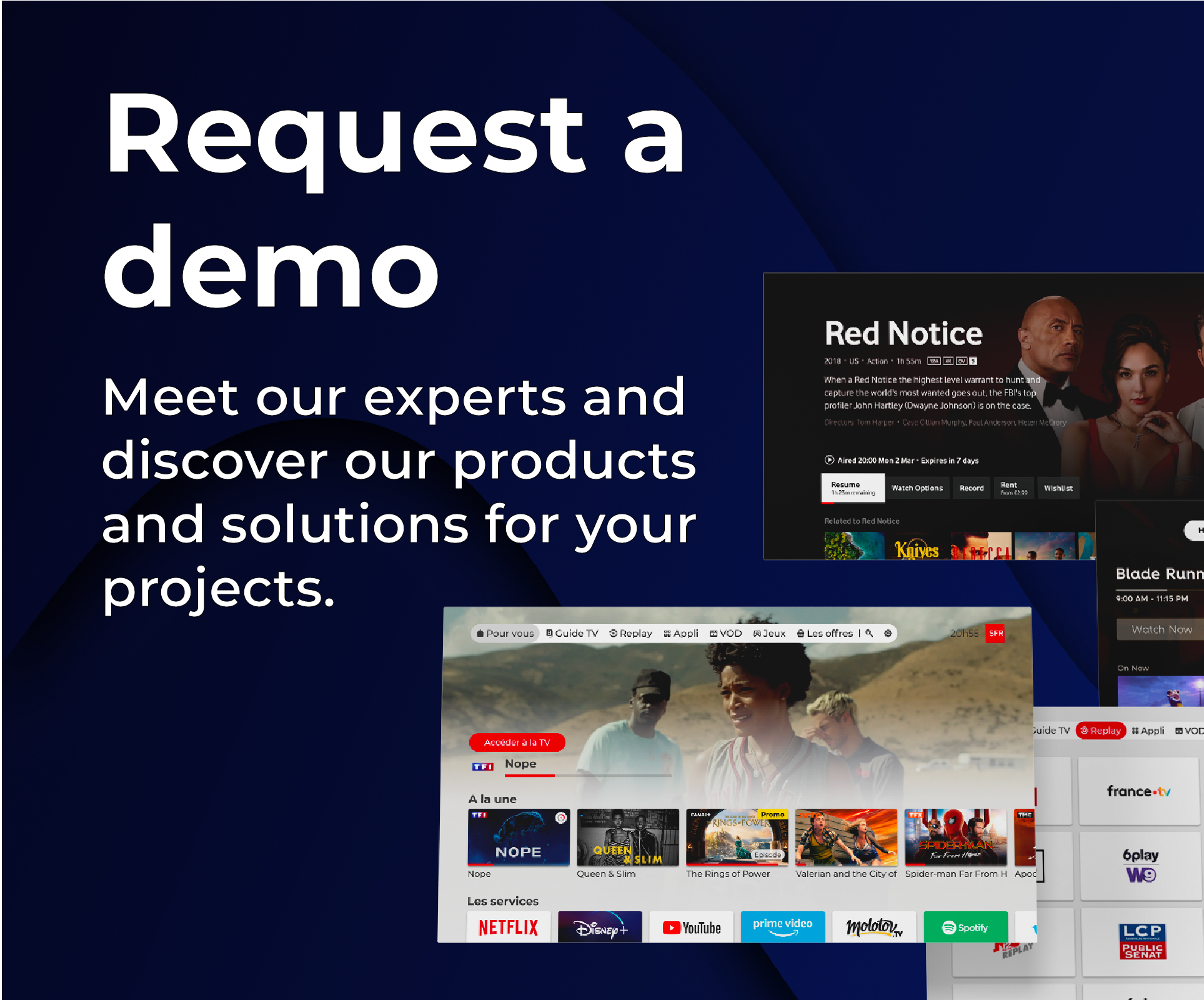In 2024, the era of single-device experiences is definitively behind us. Users across all age groups now demand a seamless cross-platform experience. They want their favourite shows, games and music playable across devices and locations, without any disruption during transitions.
>> Download: “Tactical guide, the 5 best practices for a unified cross-device strategy”
For the consumer, this demand appears relatively simple, but from the perspective of the provider it is anything but. Giant players such as Netflix, Hulu and TikTok have also raised the stakes, using their considerable resources to provide exceptional experiences that have not only revolutionised how content is consumed but have changed customer expectations for good.
The single-device paradigm that restricted and isolated content has been shattered. In order to survive and thrive in the current market, we must adapt to this shift. Challenges include ensuring that the UI design and functionalities are optimised for each device while maintaining a unified brand identity.
As a video content provider, it’s imperative to see this shift as an opportunity rather than a challenge. It’s an opportunity not only to improve your offering and increase the loyalty of your customer base, but to put distance between you and those competitors who are behind the adoption curve. With the right cross-device strategy and partners in place, you can quickly deliver what your customers want most: the ability to watch what they want, when, and how they want.
From getting to know the preferences of your audience to considering differences across devices, from picking the right partner to plotting your post-launch roadmap, we will explain the most important elements and milestones for your cross-platform strategy. By the time you have finished reading this piece, you will have a good idea of what you need to do and how to get there – the next steps will be up to you.
Read on to find out more:
It might seem like an obvious point, but so many complex strategies begin without prior consideration of what the target audience actually wants.
Ask yourself the following: Who are our key audience? Who are we targeting? Are we going in the right direction for growth?
Sometimes, answering these questions is easier said than done, especially if the data you have is limited. In this case, you may wish to ask members of your subscriber base first hand: What is it about your service that they like? What could be improved?
For example, for operators launching on Android TV, it’s essential to ascertain from your subscribers their preferred gaming genres to ensure you offer a diverse range of titles catering to those preferences.
The Android TV ecosystem is a complex, ever-changing environment – get help with launching on Android TV here.
Before you begin to build and invest in a cross-device strategy, ensure you have an intimate knowledge of what your audience wants and what they expect from this development. Having this information to hand will ensure your project stays focused, your goals are clear, and the outcome is known by all. This will save you both time and money in the long run.
In order for this new venture to be a success, User Experience (UX) must be the main priority. In a market where customers have abundant (and ever-growing) choice, UX needs to be simple, frictionless and – most importantly – constantly improving.
One of the most important things to remember at the outset is that no two devices are the same, and neither are manufacturers. Even newer devices from the same manufacturer will be different, with sometimes wildly different requirements. When planning your strategy, the devices and operating systems you decide to support become crucial considerations for your approach.
To provide a powerful experience across all mobile devices, the user interface needs to be robust and flexible. This means considering all elements, however small – such as animations, transitions, and how to deal with lower performance devices without compromising quality. Perhaps you will need to modify or cut certain elements for these users – the compromise is often worth it.
Another important consideration is the rendering engine you choose. HTML and CSS are better for low performance devices, for example, whereas WebGL will support state-of-the-art graphics for newer devices. The better you can segment this and customise the UX, the better your customer experience will be. By taking into account details like this, you also show your customers that you care about them and the experience they’re having – a small thing, perhaps, but something that will create loyalty in the long-term.
Mobile-friendly features are often unique and will require specific planning. For example, you must design touch-friendly UI elements, consider gesture-based interactions, and ensure responsiveness for accurate input. Our guide to the mobile experience will help.
It’s also important to ensure a homogeneous UX when launching a cross-platform strategy. For example, be sure to provide a consistent and recognizable user experience across all set-top boxes in your fleet. This means establishing standardised design elements, implementing responsive UI, maintaining consistent navigation, optimising performance, and regularly updating software. By doing so, you can deliver a seamless and familiar experience to users, regardless of the specific STB model they are using.
User experience (UX) is essential when developing a Pay TV service.
Living in a digital-first world means consumers are unforgiving with plentiful choices. UX must be fast and frictionless to keep up with competition. A well-designed and user-friendly Pay TV service enhances user satisfaction.
When users can easily find and access the content they desire, navigate through menus and options effortlessly, and enjoy a smooth viewing experience, they are more likely to be satisfied with the service. This, in turn, leads to higher customer retention and loyalty.
For example, optimise the user interface and content layout to ensure readability and usability on each screen size. Consider specific input methods and provide appropriate interactions.
To go further, check out the 3 key considerations to develop a Pay TV service on Smart TV.
Step #4: Embrace the games console
Operators including games consoles in their cross-device strategies are reaping the rewards of incredible brand recognition.
By integrating OTT video apps into gaming consoles, consumers gain access to a broader range of entertainment options beyond gaming. They can conveniently stream their favourite movies, TV shows, and other content directly through their gaming console, eliminating the need for additional devices or inputs.
This expanded functionality enhances the value proposition of the console, providing a more comprehensive entertainment experience.
For Pay TV providers, introducing video apps on gaming consoles extends reach to a wider audience. Gaming consoles have a significant user base, with many console owners being avid consumers of digital content. By offering their OTT video apps on gaming consoles, Pay TV providers can tap into this captive audience, attracting new subscribers and expanding their customer base.
Porting a UI refers to the process of adapting or migrating a user interface (UI) from one platform or device to another.
The benefits of porting your UI include reaching a wider audience, including users who prefer to use different devices – such as smartphones, tablets, laptops, and Smart TVs to remain competitive in a saturated market, you must provide compatible services on as many devices as possible.
This helps increase revenue streams through subscription fees, advertising, and other monetisation models. Having a consistent and recognisable UI across different devices is a good way to strengthen brand identity and recognition.
Use cross-platform development frameworks like the DANA Framework to write code just once and deploy it across multiple platforms.
While the concept of cross-platform experiences is an easy one to grasp, putting it into practice in a way that will delight your customers is not.
Choosing to implement this strategy without the help of an experienced and proven partner will often lead to costly mistakes and detours, reducing your budget for promotion and sometimes significantly increasing your time to market. There are many examples of this happening in the tech world, but with the right guidance you can avoid this fate and become one of the success stories.
So where do you begin in picking the right partner for your project?
The first thing you must do as a team is draw up a Request For Proposal (RFP). This document helps you to announce a project, describe it in detail, and receive bids from qualified contractors.
When writing up your RFP, there are three things you must consider above all else: your proposed business model, the timelines for your project, and the territories required for your initial launch.
Ask yourself the following questions: How will this new service make money? How soon do you want your cross-platform strategy to launch? Where are your primary audiences and where do you want to have a presence?
In our ebook “5 best practices for a unified cross-device strategy”, we provide a checklist of elements you should include in your RFP. This will help you draft a clear and focused document that will attract the highest quality bids.
>> Download: “Tactical guide, the 5 best practices for a unified cross-device strategy”
It’s easy to get caught up in the excitement of product development and the impending launch, but without a solid plan for the weeks and months post-launch you could be heading for disaster.
Technology changes quickly, as do the tastes and preferences of the consumer. With this in mind, there are several key areas that will require your regular attention. These include: graphical and technical evolutions, quality of service, audience usage, and monetisation models.
As technology evolves, you will need to keep pace with the expectations of your audience. You may also want to change and improve your brand, which can mean anything from simple font changes to a wholesale reimagining of your UI. In the event of this, we recommend you create a robust Design System in collaboration with experts – this way you can cut through any unnecessary complexity and ensure small changes can be made quickly – without inordinate cost.
You will notice that many of the key areas concerning your post-launch strategy are based on data findings. Data will be your best friend for the first months of your launch. It will tell you what is working, what isn’t, what features need tweaking, what copy is confusing or engaging your audience – ignore data at your own peril.
Schedule meetings with your key team on a regular basis to go through the key data points and plan actions if improvement is needed. Often, things will be going well, but you will still want to instil the habit of constant improvement, which will help you anticipate new opportunities and keep your customers engaged.
In this guide we’ve looked at the key steps to building an effective cross-platform strategy. Obviously all of this is easier said than done. When the time comes to take action, it pays to have an experienced guide to help map the journey and point out the potential pitfalls.
Wiztivi can help. We are global leaders in the design and development of video user interfaces and on-demand gaming, and we can help you plan and execute your cross-platform strategy on time and on budget.
Our reach is global, with more than 300 services launched across five continents for major media and telco companies, including the Vodafone Group, Viacom and Eurosport.
With more than 180 people worldwide, we are committed to developing exceptional cross-platform user experiences and cloud gaming services for a variety of key industries and clients. We can do the same for you.
Ready to set up and execute your cross-platform strategy? Wiztivi can help. With over two decades of experience designing and facilitating exceptional digital journeys, our team can help you make the right decisions and put your plan into action. Whether you need a consultant for a specific part of your project, or a full-time partner to guide the way, we can help make your cross-device vision a reality. Get in touch to find out more.




%20pour%20blog.png?width=1535&height=528&name=CTA%20DL%20Ebook%20UI%201%20(Tactical%20Guide)%20pour%20blog.png)